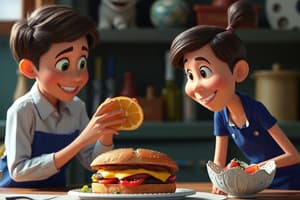Podcast
Questions and Answers
Which of the following elements is commonly used in food staging to enhance the overall scene?
Which of the following elements is commonly used in food staging to enhance the overall scene?
- Fresh flowers (correct)
- Frozen ice cubes
- Neon lights
- Plastic utensils
Post production involves adjusting exposure and color balance to enhance the aesthetic impact of the food image.
Post production involves adjusting exposure and color balance to enhance the aesthetic impact of the food image.
True (A)
What is a key ethical consideration in food photography?
What is a key ethical consideration in food photography?
Accurate representation of food
In food photography, the meticulous handling of ___________ is crucial to achieve the desired visual appeal.
In food photography, the meticulous handling of ___________ is crucial to achieve the desired visual appeal.
Match the following actions with their purposes in food photography:
Match the following actions with their purposes in food photography:
Which of the following composition principles is commonly used in food photography?
Which of the following composition principles is commonly used in food photography?
Using harsh shadows is preferred in food photography to enhance presentation.
Using harsh shadows is preferred in food photography to enhance presentation.
What type of lens is vital for capturing close-up details of food?
What type of lens is vital for capturing close-up details of food?
In food photography, _____ plays a critical role in creating visual effects and mood.
In food photography, _____ plays a critical role in creating visual effects and mood.
Match the type of lighting with its description:
Match the type of lighting with its description:
What is essential to maintain stable shots during photography?
What is essential to maintain stable shots during photography?
Food styling is not an important aspect of food photography.
Food styling is not an important aspect of food photography.
Name one post-processing technique commonly used in food photography.
Name one post-processing technique commonly used in food photography.
Flashcards
Composition in Food Photography
Composition in Food Photography
Using the rule of thirds, leading lines, and symmetry to guide the viewer's eye and create visual interest.
Lighting in Food Photography
Lighting in Food Photography
Using different types of lighting, like softboxes and spotlights, to create different moods and aesthetics.
Macro Photography of Food
Macro Photography of Food
A close-up perspective that captures the details and textures of food items.
Food Styling
Food Styling
Signup and view all the flashcards
Props in Food Photography
Props in Food Photography
Signup and view all the flashcards
Post-Processing in Food Photography
Post-Processing in Food Photography
Signup and view all the flashcards
Highlighting Texture and Color in Food Photography
Highlighting Texture and Color in Food Photography
Signup and view all the flashcards
Food Considerations in Photography
Food Considerations in Photography
Signup and view all the flashcards
Post-Production in Food Photography
Post-Production in Food Photography
Signup and view all the flashcards
Refining Image Aesthetics
Refining Image Aesthetics
Signup and view all the flashcards
Cleaning Up the Image
Cleaning Up the Image
Signup and view all the flashcards
Enhancing Image Quality
Enhancing Image Quality
Signup and view all the flashcards
Creating Mood and Style
Creating Mood and Style
Signup and view all the flashcards
Study Notes
Composition and Lighting
- Food photography uses composition principles like rule of thirds, leading lines, and symmetry to create visual interest.
- Carefully placing food in the frame highlights key features.
- Lighting is crucial; natural soft light is often preferred, but artificial light provides control over mood and aesthetics. Various light sources, from softboxes to spotlights, can be used.
- Shadows enhance depth and dimension, but harsh shadows diminish presentation.
- Understanding light direction (front, back, side lighting) is vital for different visual effects.
Equipment and Techniques
- High-quality cameras and lenses are essential for capturing food details and textures.
- Different lenses suit various perspectives and food types.
- Macro lenses capture close-up details like cake frosting or berry dew.
- Tripods provide stable shots, especially in low light or for long exposures.
- Post-processing enhances color, contrast, and sharpness using photo editing software.
Styling and Presentation
- Visually appealing presentation is as important as photographic technique. Setting the scene is as critical as capturing the food.
- Food styling involves arranging dishes attractively on plates, platters, or other surfaces. Props like tableware, napkins, and cutlery enhance visuals and storytelling.
- Creating a narrative about the food item through the entire image is key; the image should tell a story.
- Using fresh, high-quality ingredients, showcasing their natural beauty, is highly valued.
- Well-integrated props can improve viewer engagement with the product.
Specific Food Considerations
- Different foods require varied approaches; fruits, vegetables, sweets, meats, and other dishes have specific needs.
- Capturing food texture and color is essential for visual appeal; lighting highlights specific textures.
- Delicate foods need careful handling and precise focus settings.
- Staging can involve fresh flowers, candles, or other elements to create mood and enhance the scene.
Post Production
- Photo editing software is used to refine and enhance captured images.
- Adjusting color balance, exposure, and contrast ensures the image reflects the food's essence and enhances aesthetics.
- Removing blemishes, dust, and distractions from backgrounds is critical.
- Sharpening, noise reduction, and lighting adjustments produce superior quality.
- Filters and adjustments create specific moods and styles in the final image.
Ethical Considerations
- Food photography should accurately represent the food to avoid misrepresentation or deceptive marketing.
- Ethical considerations in food photography encompass ethical sourcing, environmental impact, and avoiding harmful food products.
Studying That Suits You
Use AI to generate personalized quizzes and flashcards to suit your learning preferences.




